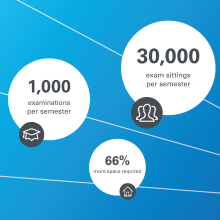Four Corona semesters have passed, and the universities as well as their staff and students are slowly beginning to recover from the rigors to which they were subjected during the pandemic. Everyone is well aware of the great efforts made to maintain the functioning of the university during this period. The switch from in-person to digital formats is often cited first because it revolutionized an entire system. However, successfully conducting in-person exams was an equally enormous challenge and accomplishment. We shed more light on these efforts and achievements below.
Even at the beginning of the pandemic and despite all the lock downs, the universities, including the University of Stuttgart, were tasked with enabling on-site examinations so as not to impede the careers of students and doctoral candidates.
Is it possible to put a figure on the extra effort that has gone into this? Only with some degree difficulty. That’s because the interactions and the complexity of the requirements and the university system are too great. We attempt an approach by taking a look at the past four Corona semesters, summer semester 2020, winter semester 2020/21, summer semester 2021, and winter semester 2021/22, and focusing on one crucial bottleneck: the provision of space.
Space and time
Two parameters are critical to capturing the challenges associated with examination dates: the distribution or room occupancy key as well as the scheduling availability of rooms.
The distribution or room occupancy key specifies the extent to which a room may be occupied. In “normal” times, the ratio for examinations is around 1:6, i.e., an exam taker needs six places in order to prevent “wandering eyes”. During the pandemic restrictions this ratio increased to 1:10 because of hygiene and spacing. The space requirement thus increased by 66 percent based on the distribution key alone.
At the same time, the availability of space decreased. This is because the longer cleaning and disinfection intervals between examinations meant that the lecture halls were used less frequently – only three exam slots each day instead of four. The 66percent increase in space requirement was thus offset here by a 25 percent decrease in exam slots.
The change resulting from the additional demand for rooms and the simultaneous shortage of exam slots can hardly be represented mathematically (and linguistically) because the demand for rooms and the need for exam slots are too different to be offset against each other. If you try it anyway, you’ll probably end up doubling the requirement – because if 166 percent is only three quarters, the whole requirement is over 200 percent.
Diet or new clothes?
To make an illustrative comparison, imagine a person who increases their body weight from 50 kg – with an arbitrarily assumed clothing size of 38 – to 83 kg and is then offered a size 34. It is obvious that either the clothing or the body of the person – or both – would be damaged.
Accordingly, the university management and the many employees involved (the number of which did not increase by 66 percent) had to do everything in its power to prevent a “bursting at the seams”. And it succeeded. In a considerable effort, it rented numerous external premises and sometimes moved large examinations to the evening hours and/or Saturdays. Or, in keeping with the metaphor: Diet was ruled out; instead, new fabrics were procured, internal and external tailors were summoned, and the measuring, cutting, and sewing began.
Figures that are worth noting
All in all, it was possible to set up about 1,000 exams per Corona semester (a slight increase compared with the time before Corona – but probably because everything, even small exams, was reported centrally).
This equates to an average of 30,000 exam sittings per semester (for clarification: 30,000 exam sittings can be imagined as two exam sittings each for 15,000 students). Even though in absolute terms this is 2,000 fewer exam sittings than before Corona – in relation to the slightly declining total number of students, the number of exam sittings per capita has actually increased slightly.
To all those who made this possible, the University of Stuttgart says: thank you!
Sources and further information
- Division 3 – University studies
- Student statistics [DE]



